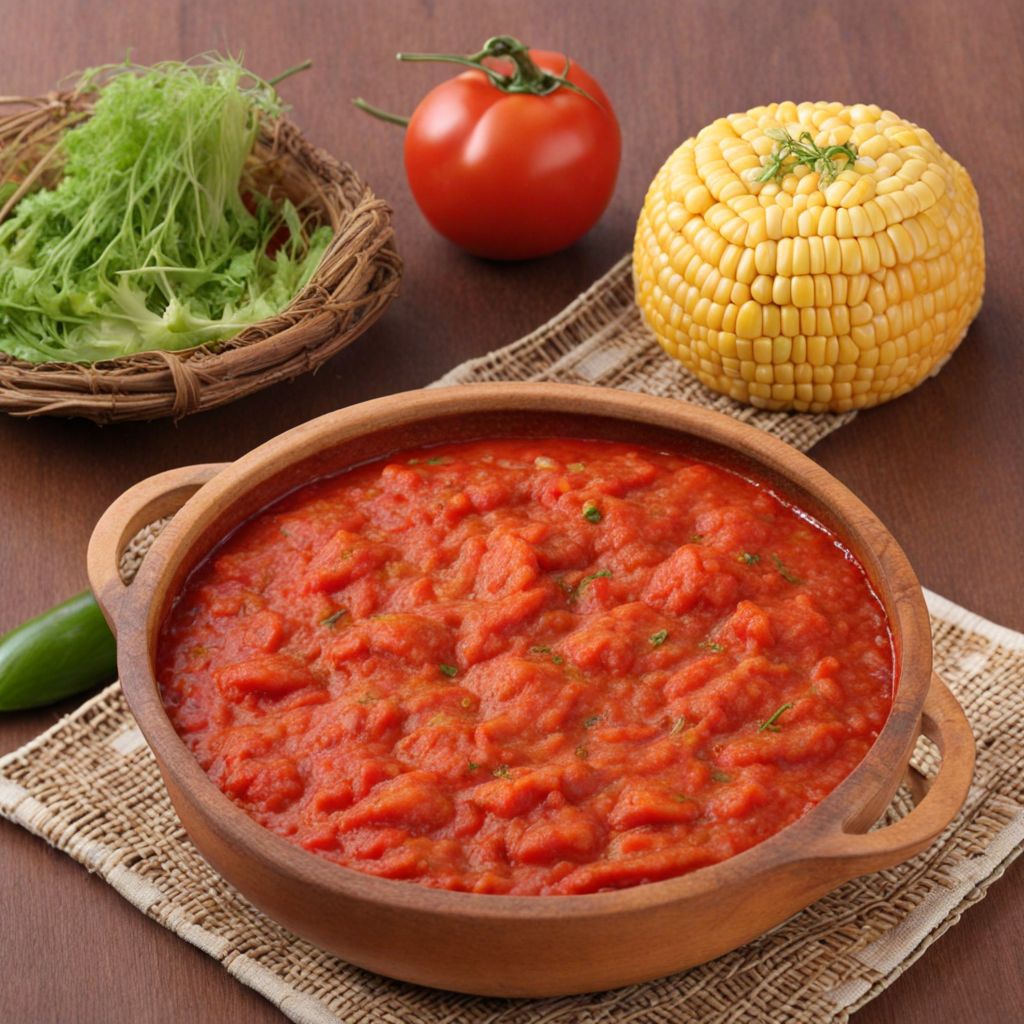Agbelima
Agbelima is a traditional dish hailing from Benin, known for its unique combination of flavors and textures that reflect the country's rich culinary heritage. At its core, Agbelima consists of a savory mix of boiled and mashed yam, often seasoned with local spices and herbs. The yam is typically cooked to a creamy consistency, which forms a delightful base for the dish, while the specific choice of seasonings can vary by region, incorporating ingredients such as ginger, garlic, and chili peppers for added depth and warmth. The dish is frequently accompanied by a variety of sauces or stews, often made with rich, flavorful ingredients like palm oil, smoked fish, or meat, which further enhances the taste experience. This combination allows for a wonderful interplay of flavors; the creamy yam contrasts beautifully with the bold, spicy sauces, creating a satisfying dish that pleases the palate. Additionally, the use of fresh vegetables in the stews adds a vibrant touch and increases the nutritional value, making Agbelima not only delicious but also wholesome. Eating Agbelima is not just about the taste; it's also a cultural experience. Traditionally served in communal settings, it encourages sharing and connection among family and friends. The act of gathering around a steaming pot of Agbelima, dipping pieces of yam into the hearty sauce, embodies the essence of Beninese hospitality and warmth. For anyone looking to explore new culinary horizons, Agbelima offers a delightful journey into the flavors of West Africa, inviting you to savor each bite and discover the stories behind this beloved dish.
How It Became This Dish
Agbelima: A Culinary Journey from Benin #### Origins of Agbelima Agbelima is a traditional dish from Benin, a country in West Africa that boasts a rich tapestry of cultural heritage and diverse culinary practices. The name "Agbelima" is derived from the Fon language, one of the principal languages spoken in Benin, and it translates to “pounded yam.” This dish primarily consists of yam that is boiled and then pounded into a smooth, stretchy paste. It serves as a staple carbohydrate source for many communities in Benin and is often accompanied by a variety of sauces and soups, making it a versatile component of the Beninese diet. Yams are believed to have been cultivated in West Africa for thousands of years, with archaeological evidence suggesting their domestication as far back as 3000 B.C. The climatic conditions of the region, characterized by rich volcanic soil and a humid tropical climate, have made yam cultivation particularly fruitful. Over time, the yam became a symbol of sustenance and health, deeply embedded in the agricultural practices and culinary traditions of the people. #### Cultural Significance Agbelima holds a significant cultural place in the hearts of the Beninese people. It is more than just a dish; it represents community, identity, and celebration. In traditional ceremonies, such as weddings, festivals, and rites of passage, Agbelima often takes center stage, served alongside flavorful stews and sauces made from local ingredients like palm oil, fish, and vegetables. The preparation of Agbelima often involves communal effort, reflecting the strong bonds within families and communities. Women are typically the primary preparers of this dish, passing down the techniques and secrets of its preparation through generations. This act of making Agbelima together fosters social connections and strengthens familial ties, underscoring the dish's role as a symbol of unity. In addition to its communal significance, Agbelima is sometimes associated with social status. The manner in which it is served, the choice of accompanying sauces, and the overall presentation can reflect the host's wealth and culinary prowess, making it an essential aspect of social gatherings and hospitality. #### Development Over Time As Benin has evolved, so too has the preparation and consumption of Agbelima. Traditionally, the process of making Agbelima was labor-intensive. Yams were harvested, peeled, boiled, and then pounded using a mortar and pestle. This method, while effective, required considerable strength and skill to achieve the desired texture. Over the years, with the introduction of modern cooking appliances, the preparation of Agbelima has become more accessible. Electric blenders and food processors have simplified the pounding process, allowing for a smoother texture in less time. However, even with these advancements, many remain devoted to the traditional methods, believing that the authentic taste and texture of Agbelima can only be achieved through manual pounding. This debate highlights a broader conversation about the preservation of culinary traditions in the face of modernization. While some families embrace technology, others hold steadfast to the methods passed down through generations, ensuring that the cultural essence of Agbelima remains intact. The ingredients used in Agbelima have also evolved. While the dish is traditionally made with yam, variations now exist depending on regional availability and personal preference. In some areas, other starchy vegetables like cassava or plantains may be used as substitutes or mixed with yam to create unique flavors and textures. Additionally, the sauces that accompany Agbelima have diversified, incorporating different proteins, vegetables, and spices reflective of the region's culinary landscape. #### Agbelima in Contemporary Society Today, Agbelima remains a beloved dish not only in Benin but also among the diaspora. As Beninese communities have spread across the globe, they have brought their culinary traditions with them, introducing Agbelima to new audiences. In cities with significant Beninese populations, restaurants and food festivals often feature Agbelima, celebrating the dish as a representation of cultural pride and heritage. The globalization of food has also played a role in the evolution of Agbelima. As international cuisines blend and influence one another, chefs and home cooks alike experiment with traditional recipes to create innovative dishes. This fusion has led to unique interpretations of Agbelima, where it may be served with non-traditional sauces or presented in contemporary styles that appeal to wider audiences. #### Conclusion: A Dish of Resilience and Identity Agbelima is more than just a staple food in Benin; it is a profound cultural artifact that encapsulates the history, values, and communal spirit of its people. Its preparation signifies resilience, as generations have adapted and preserved their culinary heritage despite changes brought about by modernization and globalization. As the world continues to evolve, so too will Agbelima, but its essence as a dish that brings people together and reflects cultural identity will remain steadfast. Whether served at a family gathering, a community celebration, or in a modern restaurant, Agbelima will always hold a place of honor in the culinary landscape of Benin and among those who cherish its rich history. Its journey from traditional roots to contemporary adaptations embodies the spirit of cultural continuity and the celebration of a shared heritage.
You may like
Discover local flavors from Benin







